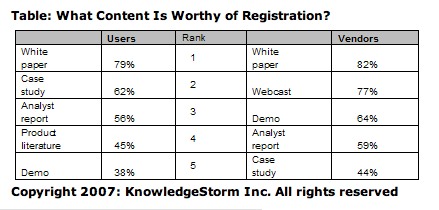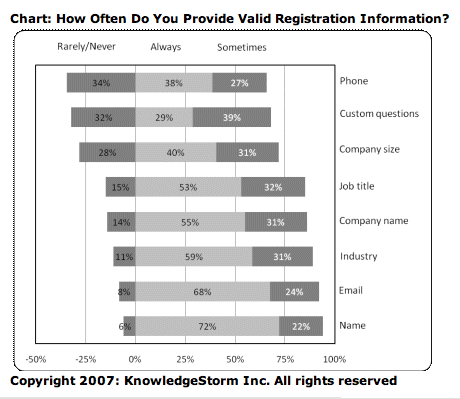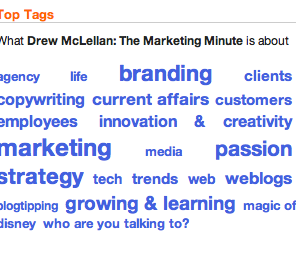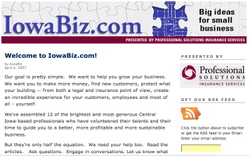You want my name and e-mail address? What’s it going to take?
May 14, 2007
So, part of your marketing strategy is to capture contact information off your website. You might offer a free webinar or white paper. But what will be enticing enough for your visitors to cough up their info? And actually give you real data?
MarketingSherpa and KnowledgeStorm did a survey to ask just those sorts of questions. Here are some interesting stats from their research summary. You’ll be able to view all the results on KnowledgeStorm’s website in a few weeks.
What will prompt someone to register?
The golden oldie — the white paper still reigns supreme. But case studies are close behind. Vendors are clearly more tolerant (which makes sense) than users. But even product literature is at a respectable 45%.
Will I go by Drew McLellan or Derek Monohan?
This is the chart that fascinated me. I’m a little embarrassed to admit this, but it has never even occurred to me to put false information into the form. I am sure it speaks to my own foolishness or something. Makes you want to come try to sell me something doesn’t it? But, it’s fascinating to study what people guard and what they’re pretty free with. Why would someone lie more often about their title than their name? And who cares what industry you’re in?
This chart reminded me of a very insightful post that Matt Dickman wrote in March about the impact of trying to collect too much data too fast.
What do you think? If you had to give your website a letter grade today — how are you doing on this stuff? Are you offering the right mix of enticements? Are you asking for too much or too little information?
What could you do differently that would improve your results?
More


![Reblog this post [with Zemanta]](http://img.zemanta.com/reblog_e.png?x-id=d0b40efd-e058-4bc6-8ce6-7f2a82b72e56)

![Reblog this post [with Zemanta]](http://img.zemanta.com/reblog_e.png?x-id=e19fc139-4b55-4719-87de-861a28372b44)

![Reblog this post [with Zemanta]](http://img.zemanta.com/reblog_e.png?x-id=e2ef15a0-b5ab-4ec7-b33c-7c9ae5fb9104)

![Reblog this post [with Zemanta]](http://img.zemanta.com/reblog_e.png?x-id=8f4f0f4f-d92f-487b-bf3f-233a2cb51da1)

![Reblog this post [with Zemanta]](http://img.zemanta.com/reblog_e.png?x-id=7655b14a-94c1-4036-a553-23657e855bd2)

![Reblog this post [with Zemanta]](http://img.zemanta.com/reblog_e.png?x-id=cf3e27e7-e444-4349-a8af-fc6615044e00)

![Reblog this post [with Zemanta]](http://img.zemanta.com/reblog_e.png?x-id=70963e49-c539-4010-91de-87c6cb38e011)

![Reblog this post [with Zemanta]](http://img.zemanta.com/reblog_e.png?x-id=543a9a8a-a731-45dd-a1f7-1e9f50f1d19d)


![Reblog this post [with Zemanta]](http://img.zemanta.com/reblog_e.png?x-id=eaafe57c-1499-484a-9aa2-93d3c2e2cceb)

![Reblog this post [with Zemanta]](http://img.zemanta.com/reblog_e.png?x-id=4cb5a2ee-4a71-4517-936a-688e77339b79)